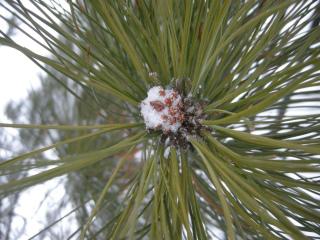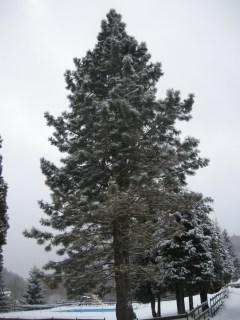
Pinus jeffreyi leaves (30/12/2011, Mala Moravka, Czech Republic)
Position: Full sun
Flowering period: N/A
Soil: Well drained, sandy/ gravely
Eventual Height: 40m
Eventual Spread: 15m
Hardiness: 5b – 8b
Family: Pinaceae
Pinus jeffreyi forms a large, upright sparse spire, evergreen tree. The green/ blue leaves are needle like, up to 20cm long, appear in groups of three and densely packed. The branches are usually horizontal and its bark is blackish and slightly craggy. The cones are up to 25cm long, conical and pointed. The roots of this tree are deep and are sensitive to soil compaction.
Pinus jeffreyi, commonly known as the Jeffrey Pine, is native to south west United States to north Mexico. It is a high altitude Pine, growing up to 2,900m in its native habitat. It was introduced into the UK in 1853. The resin of the is tree contains n-heptane which is explosive when ignited. On warm days this tree gives of a fruity fragrance of bananas or pineapples due to the volatile compound content in its resin.
The etymological root of the binomial name Pinus is derived from the Latin name for Pine tree. Jeffreyi is named after he botanist John Jeffrey (1826 – 1854) who discovered this tree.

Pinus jeffreyi (30/12/2011, Mala Moravka, Czech Republic)
The landscape architect may find Pinus jeffreyi useful on the reclamation of acid mine waste sites. It may also be used as a specimen tree where space allows. It is suitable for hot locations, is resistant to urban pollution, and once established is drought tolerant. Generally, this tree grows best at higher elevations.
Ecologically P. jeffreyi provides cover for birds. The seeds are eaten by insects, small mammals and birds.
The Royal Horticultural Society has given P. jeffreyi their prestigious Award of Garden Merit in 1993.
P. jeffreyi prefers well-drained sandy/ gravelly soils. It will tolerate most pH of soil, although it prefers acidic soils. It will tolerate poor soils. It will not tolerate compacted soils.
P. jeffreyi requires little maintenance.
Advertisement
